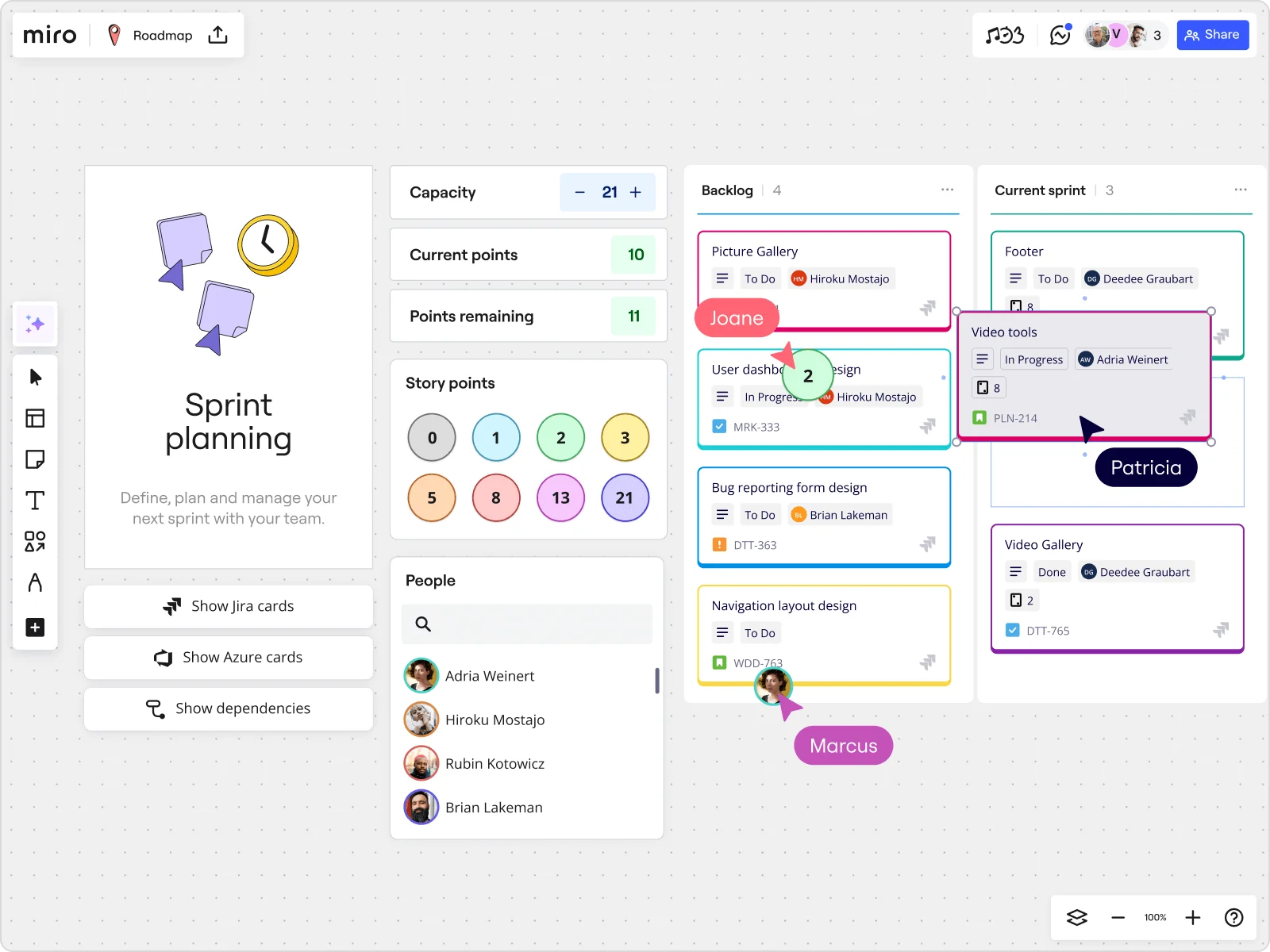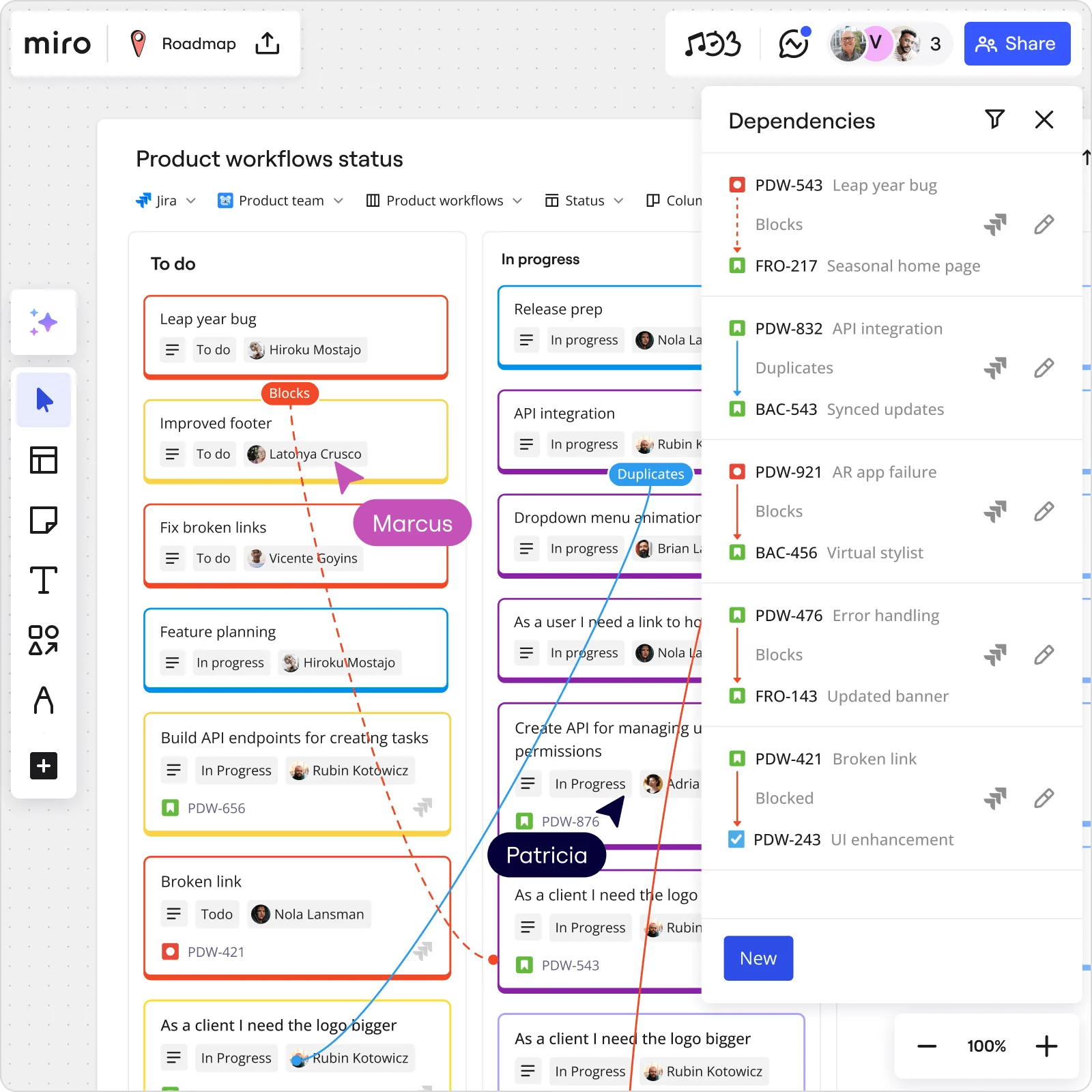
Table of contents
Table of contents
Scrum best practices — the ultimate checklist

Summary
In this guide, you will learn:
Best practices for Scrum meetings.
How to integrate testing into each sprint.
Using Miro’s innovation workspace for Scrum collaboration.
Tips for improving sprint planning, daily stand-ups, and retrospectives.
How Miro’s Scrum templates and tools support workflows.
The importance of clear communication between developers and testers.
Try Miro now
Join thousands of teams using Miro to do their best work yet.
If you’ve ever felt like herding cats would be easier than running a smooth Scrum sprint, you’re not alone.
Scrum best practices are the secret sauce that turns chaos into collaboration, but mastering them can feel like a full-time job. Whether you’re a Scrum Master keeping the ship steady or leading a team into Agile waters, this guide will help you dodge the common pitfalls that sink projects. Let’s cut through the noise, avoid the traps, and make Scrum work for you — not the other way around.
Scrum methodology — quick recap
Scrum isn't just a buzzword; it's a methodology that propels teams to innovate and deliver. It offers a structured framework for tackling complex projects. But its real strength lies in its flexibility and adaptability.
At its core, Scrum is about people and collaboration. It fosters an environment where teams can focus on delivering value quickly. This iterative process allows for regular feedback and ongoing improvement.
Key features of Scrum
Sprints: Short, time-boxed cycles for achieving specific goals.
Scrum Board: A visual tool to track progress.
Ceremonies: Regular meetings to keep everyone aligned and moving forward.
Understanding these components is essential. They provide the foundation for creating a dynamic team environment. But just knowing them isn't enough; practicing Scrum requires commitment and diligence.
The role of Scrum in innovation is significant. It encourages creativity and experimentation. Teams can iterate rapidly, learn, and adjust swiftly to changes. This makes Scrum invaluable for any product team aiming for agile success.
Scrum Master
The Scrum Master holds a pivotal role in the success of any Scrum team. They're not mere facilitators; they serve as servant leaders dedicated to team improvement. Their focus is on creating a productive work environment where team members can excel.
Scrum Masters help teams navigate the Scrum framework. They ensure everyone understands and follows the Scrum principles. By guiding daily practices, they help maintain the rhythm and consistency that Scrum demands.
Responsibilities of a Scrum Master
Coaching: Foster understanding and self-management among team members.
Facilitating: Ensure effective execution of Scrum ceremonies.
Removing impediments: Address issues that block team progress.
A great Scrum Master empowers the team to resolve challenges independently. They encourage collaboration, communication, and continuous improvement. But they also step in when obstacles become significant roadblocks.
Choosing the right person for this role is critical. The best Scrum Masters have a combination of technical insight, empathy, and leadership. They help teams identify areas for growth and ensure alignment with the overarching project goals. Their influence extends beyond the team, impacting product development and organizational strategy positively.
Scrum board best practices
A well-organized Scrum Board can be a game-changer. It's a visual tool that keeps the team aligned and informed. By tracking tasks and progress, it provides clarity and transparency.
First, ensure your Scrum Board is easy to interpret at a glance. Group items logically—separating to-do tasks, tasks in progress, and completed ones. Use colors and labels to highlight priorities and deadlines.
Encourage team members to update the board regularly. This enhances the team's ability to make informed decisions. A real-time reflection of progress can help identify bottlenecks quickly.

Key components for an effective Scrum Board
Columns: Separate into stages like Backlog, In Progress, and Done.
Cards: Use cards to represent individual tasks or user stories.
Visual cues: Leverage colors and icons to show priority or status.
By following these best practices, teams can boost efficiency and collaboration. An up-to-date board empowers everyone to anticipate challenges and adjust strategies proactively. A productive Scrum Board isn't static; it evolves as the team grows and learns. Integrating such practices will help maximize your team's potential and keep everyone on track with the current sprint goals.
Daily Scrum best practices
Daily Scrums serve as a quick, focused touchpoint for the team. This time-boxed meeting is your opportunity to align everyone’s efforts. Aim for a short, effective meeting that provides clarity for the day.
It's crucial to keep Daily Scrums under 15 minutes. A strict time limit encourages concise and relevant updates. Team members should come prepared with key points to discuss.
Focus on three core questions: What did you accomplish yesterday? What do you aim to do today? Are there any blockers in your path? These guide the conversation and keep it streamlined.
Essential strategies for Daily Scrums
Consistency: Hold the meeting at the same time and place each day.
Focus: Keep discussions relevant to the sprint goals.
Engagement: Encourage active participation from all team members.
Daily Scrums are not just status updates; they foster teamwork and transparency. By sticking to these best practices, the team remains aligned and motivated. Creating a rhythm with Daily Scrums helps maintain momentum and accountability across the board. These sessions should empower the team, providing space to address and overcome obstacles collectively.
Sprint planning best practices
Sprint planning serves as the launchpad for effective sprints. It's where the team sets actionable goals and aligns on deliverables. This meeting sets the sprint’s direction and ensures clarity.
Prioritize setting a clear, achievable sprint goal. This goal unites the team towards a common objective. It should be ambitious yet attainable within the sprint’s timeframe.
Collaborate closely with the Product Owner to refine backlog items. Clarity in user stories and acceptance criteria is crucial. Everyone on the team should understand what success looks like for each task.
Key elements for a successful Sprint Planning
Preparation: Bring a well-groomed backlog to the table.
Collaboration: Engage everyone in discussions about task distribution.
Feasibility: Ensure that the planned workload is realistic and manageable.
Successful Sprint Planning requires communication and foresight. Teams should leave the meeting with a shared understanding of priorities and expectations. This process is vital for maintaining a sustainable development pace. By setting a strong foundation, teams position themselves for a productive and rewarding sprint.

Sprint retrospectives best practices
Sprint Retrospectives offer a chance for teams to reflect and grow. They're crucial for fostering a culture of continuous improvement. These meetings encourage introspection and collective problem-solving.
Focus on creating an open and safe environment. Everyone should feel comfortable sharing honest feedback. Use this time to celebrate successes and tackle hurdles from the previous sprint.
The retrospective should generate actionable insights. It’s important to identify specific improvements for future sprints. Then, commit as a team to implement these changes.
Effective sprint retrospective tips
Openness: Encourage honest, constructive feedback from everyone involved.
Focus: Concentrate on both successes and challenges of the sprint.
Actionable Results: Develop a clear plan for improvements.
Rotating facilitators can bring fresh perspectives. It can also build team ownership of the improvement process. Making these meetings consistent and structured can greatly enhance team efficiency and morale.
By prioritizing retrospectives, teams can drive innovation and maintain momentum. The insights gained can optimize upcoming sprints, making the path to achieving goals smoother and more rewarding.

Backlog grooming best practices
Backlog Grooming, or refinement, plays a pivotal role in Scrum. It ensures that your backlog is organized and ready for upcoming sprints. It’s about prioritizing tasks and keeping them relevant.
Regular grooming sessions are essential. They help teams maintain clarity and direction. With well-groomed backlogs, teams can focus on the most impactful tasks.
Engaging the entire team during grooming fosters ownership and alignment. Discussing priorities ensures everyone understands the ‘why’ behind each task. This shared understanding aids in more efficient planning.
Tips for effective backlog grooming
Prioritization: Focus on what truly matters and will move the project forward.
Clarity: Make sure each backlog item is well-defined and understood by the team.
Alignment: Regularly involve the team to ensure everyone is on the same page.
Using Miro for these sessions can make backlog grooming seamless. Our innovation workspace provides visual clarity and encourages collaboration. By establishing a rhythm for grooming sessions, you can keep your projects aligned, efficient, and impactful.
Scrum ceremonies best practices
In Scrum, effective communication is paramount. Scrum meetings serve as the cornerstone of this communication, ensuring alignment and transparency among team members. From daily stand-ups to sprint reviews, these meetings foster collaboration and clarity.
Each meeting has a distinct purpose. The Daily Scrum helps teams sync and address roadblocks. Sprint Reviews showcase progress to stakeholders, while Retrospectives focus on improvement.
Preparation is key to successful meetings. Coming prepared allows you to focus discussions and make the most of the time. Clear agendas and time-boxing ensure meetings remain productive and engaging.
Practices for successful Scrum meetings
Preparation: Define goals and circulate agendas ahead of time.
Focus: Keep discussions relevant to the meeting’s purpose.
Engagement: Encourage participation and gather input from all members.
Using Miro, your team can facilitate dynamic and engaging Scrum meetings. Our innovation workspace supports both real-time and asynchronous collaboration, allowing teams to communicate effectively regardless of location. By emphasizing clear communication, Scrum meetings can drive progress and keep everyone on the same page.
Scrum testing best practices
Testing within Scrum ensures that products not only meet but exceed customer expectations. With tight iterations, maintaining quality at speed becomes a balancing act. It's vital to integrate testing seamlessly into the Scrum framework.
Continuous testing is essential. It provides insights and feedback throughout each sprint, helping teams catch issues early. This proactive approach avoids the pitfalls of last-minute testing chaos.
Involve testers from the start. By including them in planning and design sessions, their unique perspective can shape a more robust product. This upfront involvement ensures quality doesn't take a back seat.
Tips for effective Scrum testing
Integrate Testing: Blend testing into each sprint; don't save it for the end.
Automate Wisely: Use automated testing to cover repetitive and regression tasks.
Collaboration: Encourage collaboration between developers and testers for shared understanding.
By using Miro, teams can streamline these testing processes. Our innovation workspace allows teams to document testing plans, visualize test coverage, and track bug resolution efficiently. Real-time and async features enhance collaboration, ensuring quality doesn't compromise speed. With the right tools and practices, Scrum teams can deliver high-quality products swiftly and reliably.
Common pitfalls in Scrum — and how to dodge them
Scrum is powerful, but it’s not without its challenges. Even seasoned teams can stumble. Understanding common pitfalls can keep your team on the path to success.
A frequent misstep involves vague or unrefined user stories. This can lead to unclear objectives and miscommunication. Ensure stories are specific, actionable, and understood by everyone.
Another issue is the neglect of retrospectives. Teams might skip them if they feel pressed for time. However, these sessions are vital for addressing problems and fostering improvement.
Here are some key pitfalls to watch out for:
Lack of sprint goal clarity: Ensure every member knows the objective.
Ignoring stakeholder input: Engage stakeholders early and often for balanced feedback.
Inconsistent Scrum meetings: Keep meetings regular to maintain momentum.
Unclear roles can also trip up Scrum teams. When responsibilities blur, accountability suffers. Regularly revisit roles to ensure everyone knows their contribution.
Finally, resistance to change can hinder progress. Scrum relies on flexibility and innovation. Encourage openness and adaptability to turn challenges into opportunities.
By being vigilant against these pitfalls, your team can harness Scrum’s full potential and drive product excellence.
Embracing Scrum for product excellence
Scrum is more than a framework; it's a path to excellence. By adopting best practices, teams unlock potential and enhance innovation. Effective communication, clear goals, and continuous feedback form the bedrock of successful Scrum teams.
Leveraging tools like Miro can amplify this success. Miro's innovation workspace enhances teamwork with flexible and real-time collaboration. Whether roadmapping, sprint planning, or prototyping, Miro empowers teams to thrive in dynamic environments.
By being vigilant about common pitfalls and fostering a culture of learning, teams can navigate challenges with confidence. Embrace Scrum with commitment and watch your products—and team—flourish.
Author: Miro Team
Last update: October 1, 2025